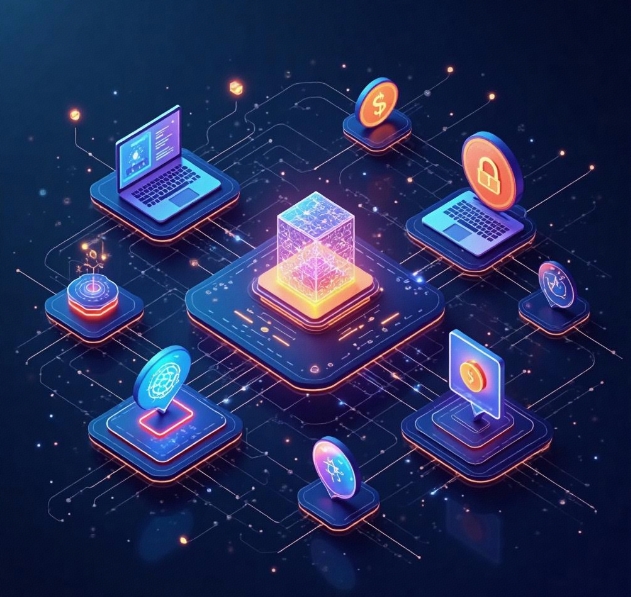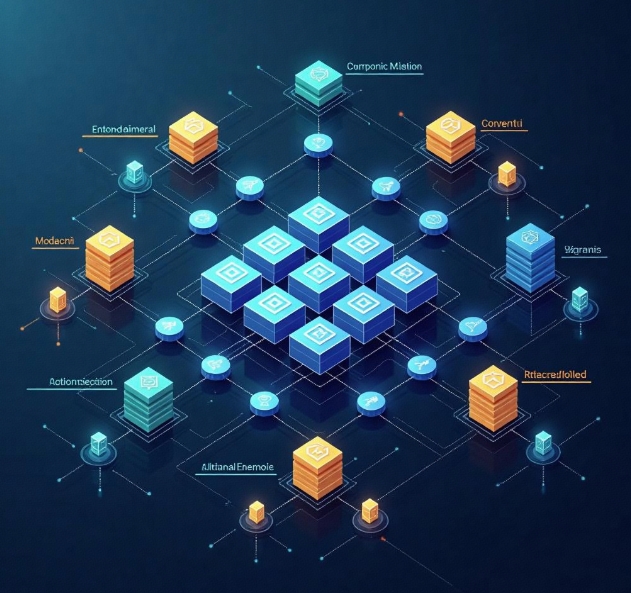How does blockchain empower Web3 development? In-depth analysis of technical architecture
- latest articles
- 1.DApp Development & Customization: Merging Diverse Market Needs with User Experience 2.Analysis of the Core Technical System in DApp Project Development 3.How to achieve cross-chain interoperability in Web3 projects? 4.How does the tokenization of points reconstruct the e-commerce ecosystem? 5.How to Set and Track Data Metrics for a Points Mall? 6.What is DApp Development? Core Concepts and Technical Analysis 7.Inventory of commonly used Web3 development tools and usage tips 8.Development of a Distribution System Integrated with Social E-commerce 9.Six Key Steps for Businesses to Build a Points Mall System 10.What is DApp Development? A Comprehensive Guide from Concept to Implementation
- Popular Articles
- 1.Future Trends and Technology Predictions for APP Development in 2025 2.Analysis of the DeFi Ecosystem: How Developers Can Participate in Decentralized Finance Innovation 3.From Zero to One: How PI Mall Revolutionizes the Traditional E-commerce Model 4.DAPP Development | Best Practices for Professional Customization and Rapid Launch 5.Recommended by the Web3 developer community: the most noteworthy forums and resources 6.From Cloud Computing to Computing Power Leasing: Building a Flexible and Scalable Computing Resource Platform 7.How to Develop a Successful Douyin Mini Program: Technical Architecture and Best Practices 8.Shared Bike System APP: The Convenient Choice in the Era of Smart Travel 9.How to Create a Successful Dating App: From Needs Analysis to User Experience Design 10.From Design to Development: The Complete Process of Bringing an APP Idea to Life
With the development of the internet, the centralized architecture of Web2 has gradually exposed issues in data security, privacy protection, and platform monopolies. As the next evolution of the internet, Web3, with its decentralized characteristics, has garnered widespread attention and research. Blockchain technology, as the core support of Web3, provides robust technical power for this new internet architecture. In this article, we will start by exploring how blockchain empowers Web3 development, delve into the technical architecture of Web3, and discuss its potential and future directions.
What is Web3?
Before discussing how blockchain empowers Web3, it's essential to clarify the basic concept of Web3. Web3 refers to a decentralized internet ecosystem, in contrast to Web1 and Web2. In the Web1 era, the internet primarily consisted of static web pages with limited user interaction. In the Web2 era, the internet became more dynamic, with rapid development in social media, content creation, and data exchange. However, during this process, centralized platforms (such as Facebook, Google, and Amazon) began to control user data, sparking widespread debates over data privacy and content control.
The core idea of Web3 is decentralization, emphasizing greater user control over their data, eliminating intermediary platforms in the traditional internet, and leveraging blockchain technology to enable decentralized applications (dApps), smart contracts, digital assets, and various other new application scenarios. In the Web3 architecture, users are not just content consumers but also creators and managers, redefining how the internet operates.
The Role of Blockchain Technology
As one of the core technologies of Web3, blockchain empowers the decentralized internet architecture. Simply put, blockchain is a decentralized distributed ledger technology that ensures secure, transparent, and traceable data recording and management without intermediaries. Its characteristics, including decentralization, immutability, transparency, and anonymity, make it highly suitable for core Web3 applications.
Decentralization: Eliminating Intermediary Trust Mechanisms
One of the core issues of Web2 is its reliance on centralized platforms for data management, requiring users to trust these platforms to store and process their data. Blockchain technology, through decentralization, distributes data storage across every node in the network, eliminating the need for centralized platforms. Users no longer need to trust a single intermediary but rely on the network's consensus mechanism to ensure data authenticity and reliability.
Immutability: Ensuring Data Security and Transparency
Another key feature of blockchain is data immutability. Once data is recorded on the blockchain, it cannot be altered or deleted, ensuring data integrity and security. In Web3 applications, this immutability is crucial, effectively preventing data forgery, tampering, and misuse by intermediary platforms.
Transparency and Traceability: Enhancing Trust Mechanisms
The public transparency of blockchain allows all data to be viewed and verified by anyone, increasing data credibility. Additionally, since every transaction on the blockchain has a detailed timestamp and ledger record, any operation can be traced back to its source, enhancing trust mechanisms within the network. This feature is particularly important for Web3's decentralized applications, as it enables users to ensure data and transaction reliability without relying on third-party trust.
Anonymity and Privacy Protection: Safeguarding User Privacy
The encryption algorithms used in blockchain ensure user anonymity during transactions and data exchanges, which is vital for Web3's privacy protection. As users increasingly value data privacy, blockchain offers an efficient way to protect privacy in Web3, allowing users to participate in the decentralized network without exposing their identities.
Analysis of Web3 Technical Architecture
The technical architecture of Web3 can be divided into the following layers: the foundational layer, the protocol layer, the application layer, and the service layer. Blockchain technology runs through all these layers, empowering the implementation of each.
1. Foundational Layer: Blockchain and Distributed Storage
The foundational layer is the underlying support of the Web3 technical architecture, including blockchain networks and distributed storage systems. Blockchain networks provide decentralized data management and consensus mechanisms, while distributed storage systems are used to store the vast amounts of user and application data in Web3.
Currently, common blockchain networks include Ethereum, Polkadot, and Solana, which ensure the smooth operation of decentralized applications through their unique consensus mechanisms and smart contracts. Ethereum, as the most renowned smart contract platform, executes smart contracts via the Ethereum Virtual Machine (EVM), making it a crucial platform for Web3 development.
At the same time, decentralized storage systems like Filecoin and Arweave provide secure and reliable data storage solutions for Web3. These distributed storage systems mitigate the risks of single points of failure and data breaches by dispersing data across multiple nodes in the network.
2. Protocol Layer: Smart Contracts and Decentralized Protocols
The protocol layer includes smart contracts and various decentralized protocols, serving as the core building blocks for Web3 applications. Smart contracts are a vital component of blockchain technology—programs that run on the blockchain and automatically execute based on predefined conditions, eliminating the need for third-party intermediaries in the traditional internet.
In Web3, smart contracts are widely applied in areas such as decentralized finance (DeFi), decentralized autonomous organizations (DAOs), digital identity, and digital asset trading. They automate the execution of complex protocols and transaction rules, offering users more efficient, transparent, and secure services.
Decentralized protocols provide the foundation for interoperability and protocol standards in the Web3 ecosystem, including decentralized identity authentication, payment protocols, and governance protocols. These protocols enable seamless connections and data sharing between different decentralized applications, fostering the healthy development of the Web3 ecosystem.
3. Application Layer: Decentralized Applications (dApps)
The application layer is the most visible part of the Web3 technical architecture, encompassing various decentralized applications (dApps). Decentralized applications are the practical implementations of Web3, typically built on blockchain technology and utilizing smart contracts and decentralized protocols to provide services to users.
Decentralized finance (DeFi) is currently the most mature and widespread field in Web3 applications, disrupting the traditional financial industry through decentralized lending, trading, insurance, and other financial services. Other emerging application scenarios include decentralized social platforms, decentralized marketplaces, and decentralized content creation and sharing platforms.
The advantages of decentralized applications lie in their disintermediation, censorship resistance, data transparency, and strong anonymity, allowing users to better control their data and assets while avoiding platform monopolies and data breaches.
4. Service Layer: Web3 Browsers and Wallets
The service layer is the user interaction layer in the Web3 technical architecture, including Web3 browsers, wallets, and other client-side tools. Web3 browsers, such as MetaMask, allow users to interact with blockchains and decentralized applications. Web3 wallets, on the other hand, store users' digital assets and identity information, supporting functions like cryptocurrency transactions and smart contract operations.
The service layer serves as a bridge between Web3 and the traditional web. Through Web3 browsers and wallets, users can seamlessly enter the decentralized world and participate in the use and development of decentralized applications.
Advantages of Blockchain Empowering Web3 Development
1. Enhanced Data Security and Privacy Protection
The decentralization and encryption features of blockchain provide robust data protection capabilities for Web3 development. Users gain greater control over their data, mitigating risks associated with data breaches, misuse, and centralized storage.
2. Enabling Decentralized Autonomy
The decentralized nature of Web3 allows users to autonomously manage their digital identities, assets, and data, reducing platform control over data and content. The consensus mechanisms and smart contracts provided by blockchain technology make decentralized autonomous organizations (DAOs) possible, offering users a new form of governance.
3. Incentive Mechanisms and Value Flow
Blockchain technology provides flexible incentive mechanisms for Web3 applications. Through cryptocurrencies and tokenization mechanisms, developers and users can earn rewards by participating in the development, use, and maintenance of decentralized applications. These incentive mechanisms drive the construction of the Web3 ecosystem and promote the growth and innovation of decentralized applications.
Conclusion
Blockchain technology provides a solid technical foundation for the development of Web3, empowering the creation and operation of decentralized applications. As blockchain technology continues to advance, the potential of Web3 will be further realized. The decentralized internet will grant users greater autonomy, security, and privacy protection while driving innovation and disintermediation. In the future, the technical architecture of Web3 will continue to improve, with blockchain remaining its core pillar, ushering the internet into a new era of openness, fairness, and transparency.
-

How to achieve cross-chain interoperability in Web3 projects?
With the continuous development of WEB3 technology, Web3 has gradually become an···
-

Inventory of commonly used Web3 development tools and usage tips
With the continuous development of blockchain technology, Web3 has become a hot ···
-

Web3 development trend prediction: analysis of future technology directions and application scenarios
With the gradual development of blockchain technology, the concept of Web3 has m···

 Blockchain
Blockchain












